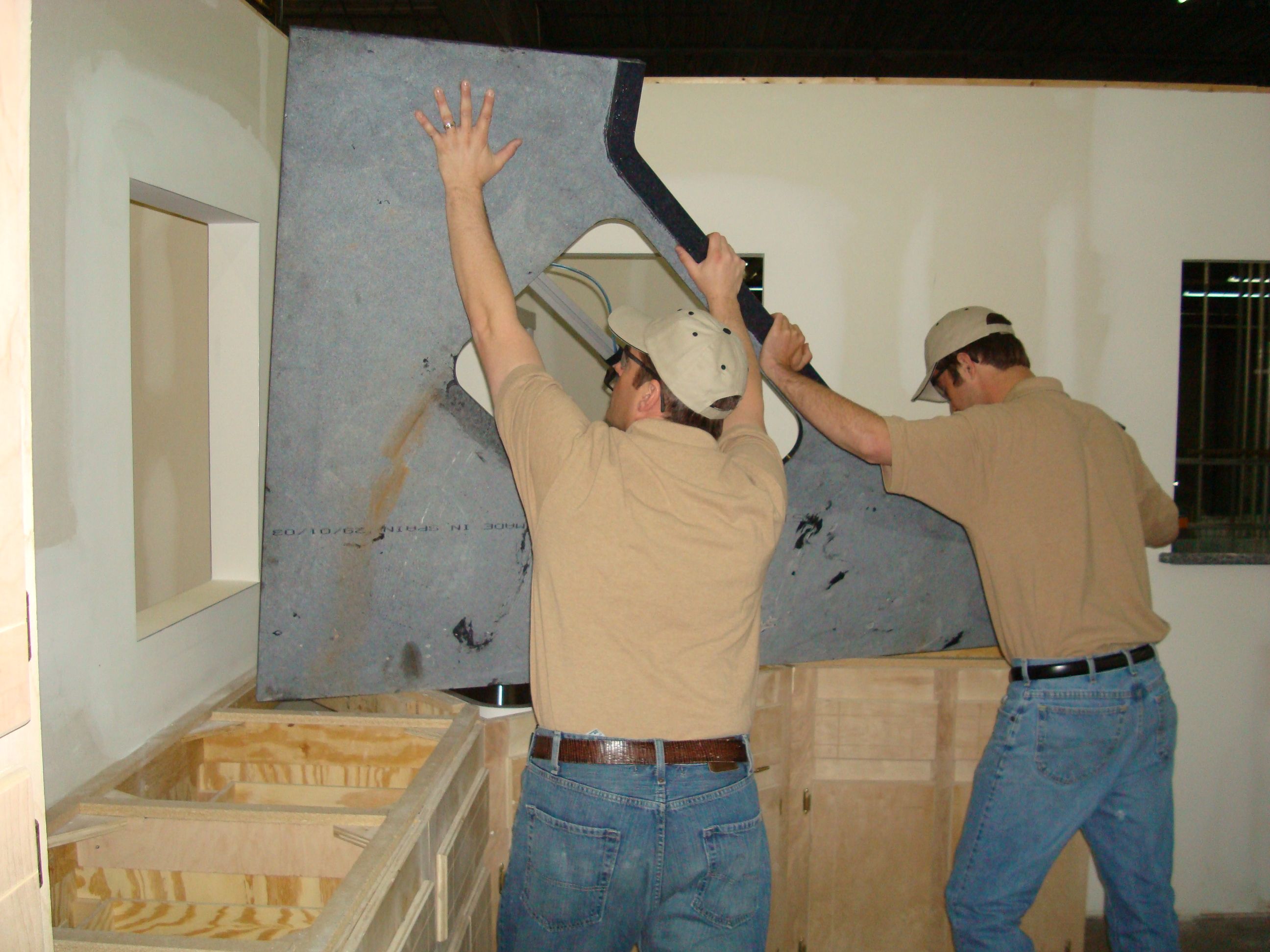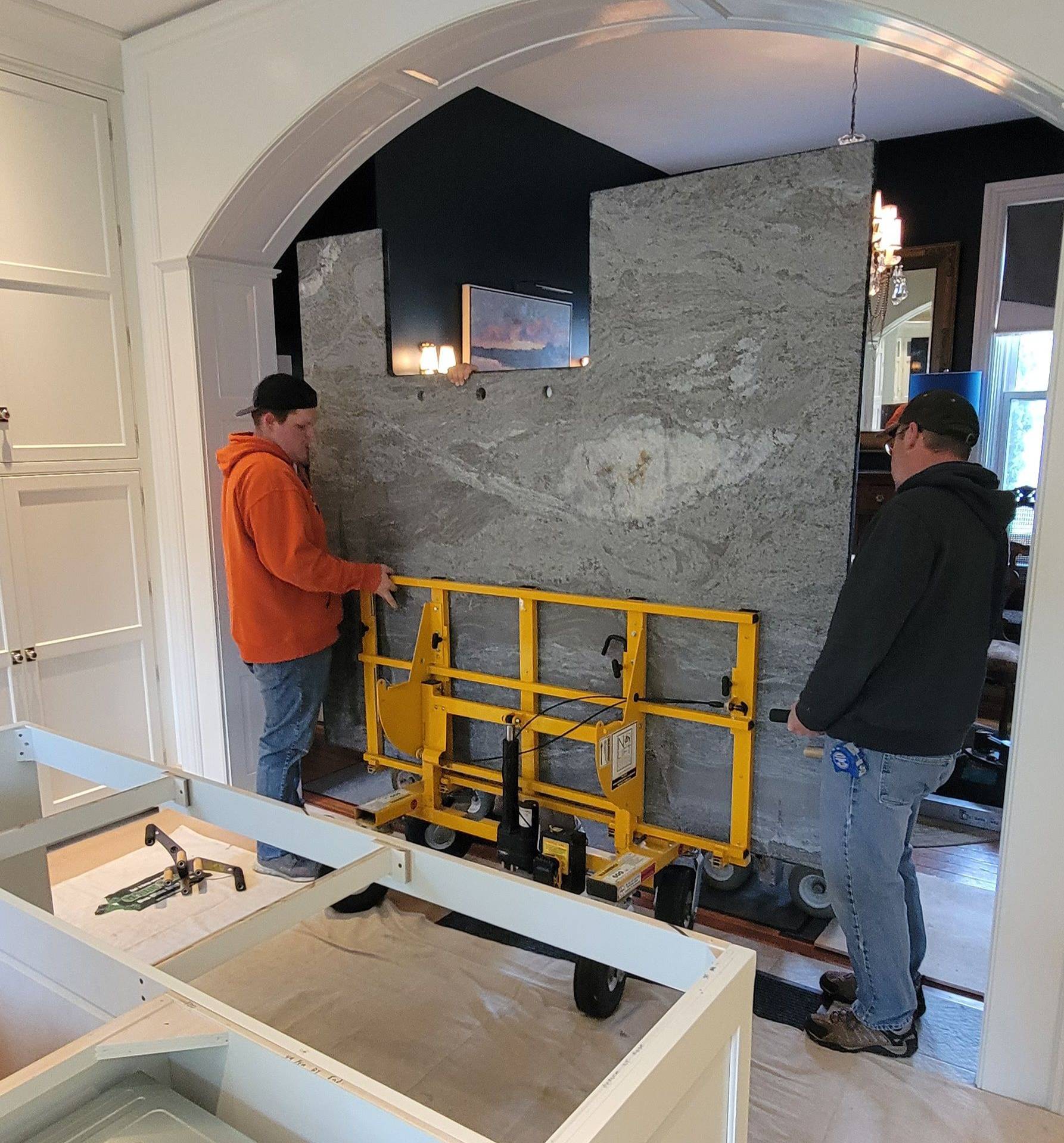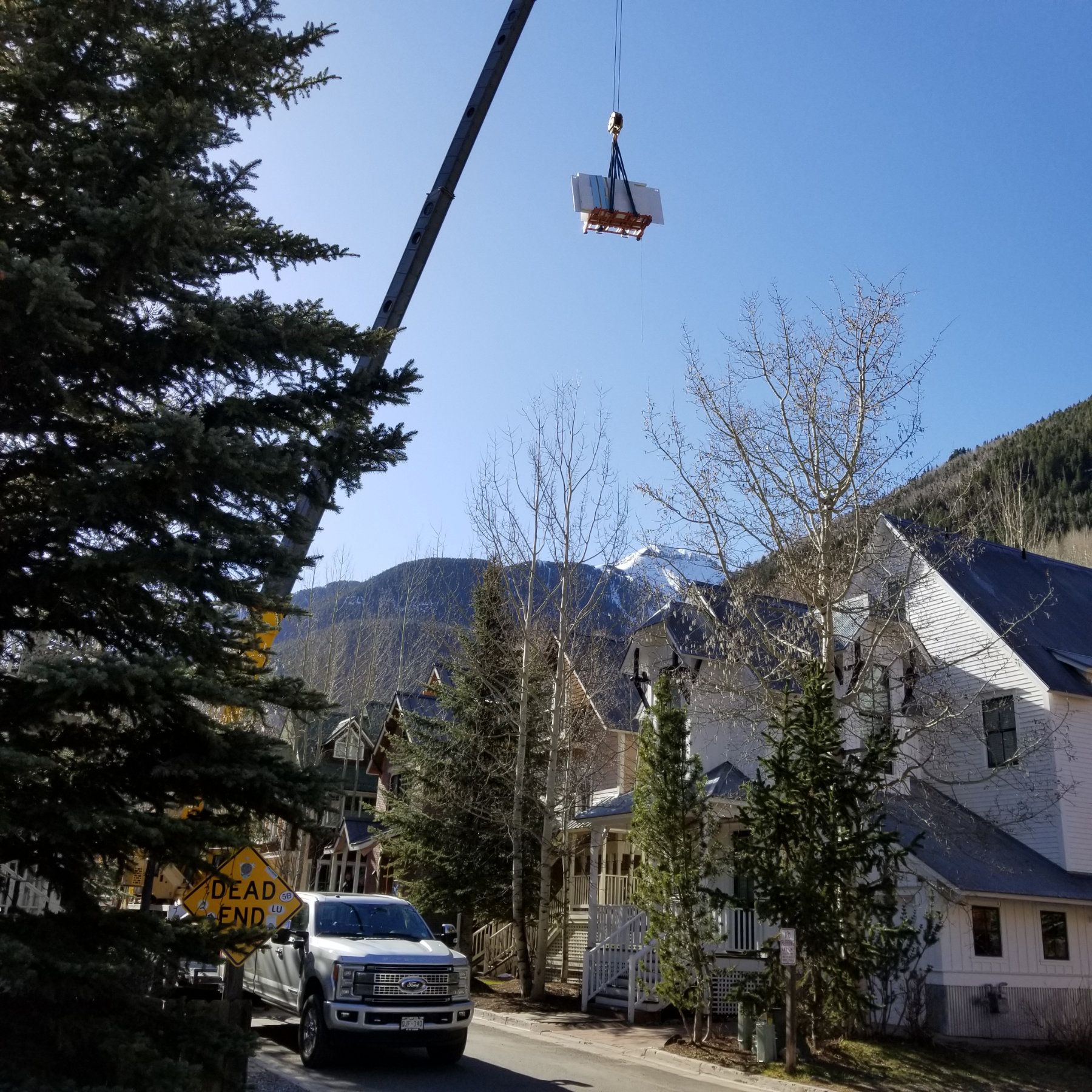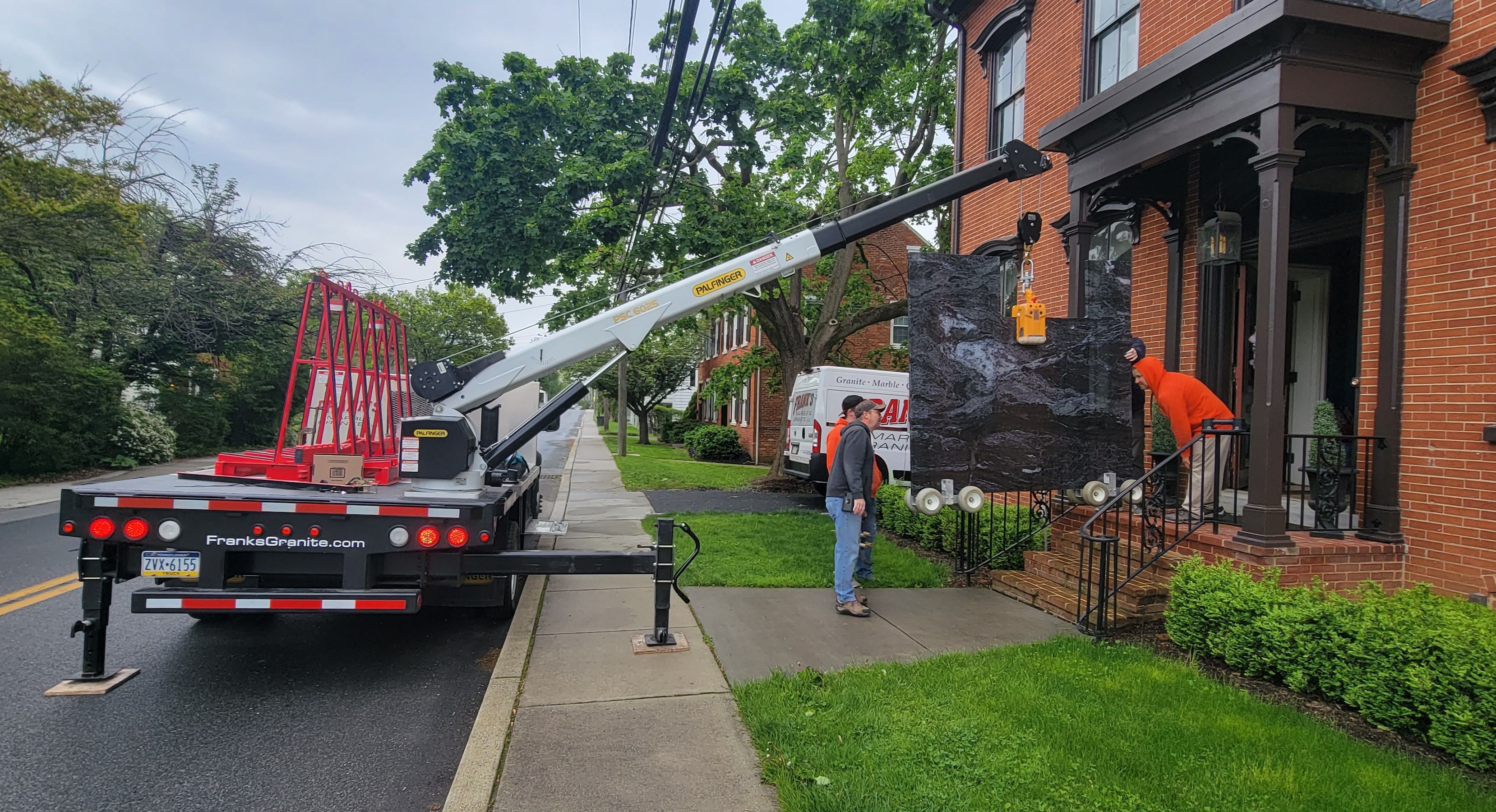How Many People Does It Take to Install a Countertop?
Nope. Not a punchline. It’s serious business to keep job parts – and workers – unbroken.
Photo by Robert Linder from Unsplash
By K. Schipper
Talk to most fabricators about their install crews, and they’ll likely tell you it typically includes two people. Or it might grow to sometimes be as large as three, depending on the shop. In reality, though, the number of people heading out the door to a jobsite can vary exponentially, depending on the size of the job, the pieces to be installed, and the site itself. And it’s not often the elements that create the greatest havoc with getting that stone to its final placement; it’s bugaboos like narrow staircases and small elevators that can be the real culprits. Although many shops claim to use a two-man crew for installations, not all do. Both Mississauga, Ont.-based Toronto Granite and Frank’s Marble and Granite in Red Lion, Pa., lay claim to utilizing three-man crews pretty much as standard.
“We have found this number works well for us in terms of efficiency and getting the job done in a timely manner,” says Mirko Petrov, Toronto Granite’s co-owner. “We’ve used this number for quite some time, and it has worked well for us. Much of our market is in condo buildings, so it’s always good to get an extra hand with lifting whenever possible.”
“As far as I can remember we’ve always sent three people,” echoes Carmine Pantano of Frank’s Marble, who grew up in the business before taking it over from his father. “As far back as I can remember it’s been three guys all the time.” Glenn Woods of Santa Rose Stone in Indio, Calif., is another believer in the three-man crew. He says that realistically, the only place a two-man crew is safe and efficient is in installing smaller jobs, such as vanity tops and steps. “It really is always changing,” Woods says. “It depends on the job, it depends on the size of the pieces, and it depends on the thickness of the stone. Obviously, with a 3cm, I need more guys. If there’s a big kitchen island, I normally have two crews in the field, but I’ll put all six guys on the first stop to have them lift the island, and then three of them will go off to another job.” The main thing that’s apparent with all these shops is that flexibility is the key. Jim Doran III, owner of Ceramic Tile Plus in Kahului, Hawaii, says his typical crew is an installer and an assistant, but that’s he’s flexible. “When we have a large island, automatically there’s a third person that goes out,” he says. “Sometimes that person will just help set that one component and then go on to another jobsite. But there are other jobs where we have four or five people, especially with very large runs or something like a complex waterfall.” Both Dave Standerfer of Standerfer Stoneworks in Soldotna, Alaska, and Andy Hohl of Precision Granite in Pagosa Springs, Colo., run small shops in rural areas, and both say there’s really no limit on the number of people they’ll send to a jobsite. “Safety for my guys and my tops are paramount,” says Standerfer. “We send the whole shop out sometimes.” Hohl has an experienced crew that both fabricates and installs, with one week dedicated to fabrication and then the next to doing installation. “We can send however many people we need to do the job,” he says. “Sometimes we’ll have a bunch of guys unload all the pieces and get them in place, and then leave two guys to finish up.”

Photo by Jason Nottestad
The idea that two will do rings true with some shops, although the corner-sink part may be the limit on a manuverable size.
Automation may have changed how jobs are processed in the shop, but at least up to now there’s only so much equipment that can help in getting that large 3cm island into a difficultly located kitchen, not that it can’t help at least get it onto the truck and out the door. “We load our truck with our overhead crane and a suction lifter,” says Hohl. “But we offload it all by hand. We have dollies to roll the bigger pieces, but primarily we’re just taking enough muscles so that no one gets hurt.” Standerfer says he has “all the normal cart types,” but there’s one he relies on. “We have a No Lift (Install System) cart, which is a game changer for bigger pieces,” he says. “With it, I purchased two of their roll-up aluminum ramps. Between those and the ramp on my van, I have about 60’ of solid surface to roll carts on, which is really helpful.” Pantano says Frank’s Marble has been using carts and dollies dating back to the days when they were handmade. Later, when suppliers began offering them, the shop bought several. And, like Standerfer, today he swears by his No Lift system, which he bought about five years ago. “That was a great addition,” he says. That’s not to say there aren’t other methods for moving material at the jobsite. For instance, Petrov’s shop truck has a hydraulic lift gate to make loading and unloading easier. And Woods says he’s sometimes able to rent or arrange to use a forklift or crane owned by the general contractor on a large project. “Of course, we don’t have that with custom homes,” Woods notes. “And the problem is always the moment where you actually set the piece in place where you don’t have any mechanical help.” Doran admits to actively researching the addition of a No Lift system to Ceramic Tile Plus, at least in part because of its rollout ramp for traversing steps. However, he also isn’t opposed to hiring a crane when it’s the best answer for an install. “We have a number of jobs where elevators are part of the process because there are a lot of condominiums here on Maui,” he says. “Sometimes the islands or the peninsulas are too big to get into an elevator, and with multiple stories it’s too hard to carry it.”

Photo courtesy Frank's Marble and Granite
While extra hands can be a plus, many crews opt for materia-assist devices such as the No-Lift Install System.
The idea of having a shop crane may sound like a bit of overkill to some fabricators, but that isn’t stopping Hohl, who says, “When I add a flatbed truck – which will probably be this year – I’ll probably put a small crane on it, too, so we can at least winch some pieces down easily.” Like Doran, he’s also doing a number of multi-story condos where sometimes hiring a crane is a necessity to get pieces to the upper floors. Although he’s not doing high-rise condos, Pantano took delivery on a crane truck in December of last year, and while he says it may be a little bigger than he strictly needs, he’s glad he made the purchase. “We’re able to go about 25’ higher than the truck, and we can go out about 25’,” he explains. “Just the other day we had a huge island – 10’ X 6’. There was no way we could get it into the bi-level house, so we told them, ‘Unless we can drive into your backyard and come over your back deck, your job is not happening.’ They had no problem with that, and it made that part of the job so much easier.” When it comes to assessing how many people to devote to a particular install, who has the final say-so varies by shop. Of course, the size and number of pieces on a job is pretty apparent once the fabrication starts. How those might get into the kitchen isn’t always so apparent. As the Precision Granite templater, Hohl has already been to the jobsite, and says he pays attention to the accessibility of the site. “We’re digitally templating, so we’re taking photos of all that,” he says. “Then, we upload pictures of the access, as well.” For Doran, the decision is usually made by the fabrication-shop manager in consultation with the installer and the assistant. “He’ll ask what they think the installation will take and how many people they’d like to take with them,” Doran says. “That usually happens a day or two before the job goes out.” Santa Rosa’s Woods says it’s just one more question that must be resolved daily. “It’s my expertise and the expertise of my guys that help us make those decisions,” Woods says. “They’re supposed to mention if they’re understaffed, and if they feel a particular piece is bigger than four guys can handle, so better send six. And, we have to arrange that.”

Photo courtesy Precision Granite
Going sky-high on installations isn't just a big-city notion. For Precision Granite in the Colorado mountains, space considerations can require the big lift ... and a bigger install crew.
So, does everyone review their installation practices to make sure they’re being their most safe, effective, and profitable? Not necessarily. “We’re always working to update and make our systems better,” says Hohl, adding that his next purchase will be a Gorilla Grip Seam Setter. “Right now, we’re doing a lot of wall panels and we’re constantly looking to do better.” “We have an annual meeting where we just throw ideas out,” says Doran. Because Ceramic Tile sells wholesale to other fabricators, a near-accident with a client picking up some work during heavy tradewinds prompted the company to set up a special loading zone, signed and painted, for slabs and prefab pieces. Both Pantano and Toronto Granite’s Petrov say they try to stay on top of their installation practices. For instance, Pantano says before the end of this year, he’ll take a hard look at what the new crane truck has done for the company and if it might be possible to go from a three-man to a two-man install crew. “You have to keep reviewing things,” Pantano says. “For one thing, help is so hard to get, and I’m trying to keep my long-term guys. And I believe by keeping them safe, they’ll stick around.” That doesn’t mean it’s okay to ignore issues in the shorter term, though. When faced with using the crane to unload a big island made fragile by the sink cutout being at the bottom, Pantano realized that his gravity clamps weren’t the best answer to lift the fabricated piece. “I ended up buying a spreader bar and sling,” he says. “That’s where I knew there had to be a better way. I found it and ordered it right away.” Petrov agrees that safety is a big part of his review process, but he adds it’s also a way to make sure he’s providing the best possible service to his customers. “We review and make adjustments as needed,” he says. “Some of the areas we focus on include safety procedures, communication with customers and installation techniques. I also attended Coverings in Orlando, where I was following new industry trends with installation. I want to make sure we’re prepared with the latest installation tools.”

Photo courtesy Frank's Marble and Granite
Even the friendly neighborhood install often offers obstacles (like the front-door stoop) where a truck crane beats the sheer brawn of extra workers.